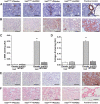Human recombinant ACE2 reduces the progression of diabetic nephropathy
- PMID: 19934006
- PMCID: PMC2809962
- DOI: 10.2337/db09-1218
Human recombinant ACE2 reduces the progression of diabetic nephropathy
Erratum in
- Diabetes. 2010 Apr;59(4):1113-4
Abstract
Objective: Diabetic nephropathy is one of the most common causes of end-stage renal failure. Inhibition of ACE2 function accelerates diabetic kidney injury, whereas renal ACE2 is downregulated in diabetic nephropathy. We examined the ability of human recombinant ACE2 (hrACE2) to slow the progression of diabetic kidney injury.
Research design and methods: Male 12-week-old diabetic Akita mice (Ins2(WT/C96Y)) and control C57BL/6J mice (Ins2(WT/WT)) were injected daily with placebo or with rhACE2 (2 mg/kg, i.p.) for 4 weeks. Albumin excretion, gene expression, histomorphometry, NADPH oxidase activity, and peptide levels were examined. The effect of hrACE2 on high glucose and angiotensin II (ANG II)-induced changes was also examined in cultured mesangial cells.
Results: Treatment with hrACE2 increased plasma ACE2 activity, normalized blood pressure, and reduced the urinary albumin excretion in Akita Ins2(WT/C96Y) mice in association with a decreased glomerular mesangial matrix expansion and normalization of increased alpha-smooth muscle actin and collagen III expression. Human recombinant ACE2 increased ANG 1-7 levels, lowered ANG II levels, and reduced NADPH oxidase activity. mRNA levels for p47(phox) and NOX2 and protein levels for protein kinase Calpha (PKCalpha) and PKCbeta1 were also normalized by treatment with hrACE2. In vitro, hrACE2 attenuated both high glucose and ANG II-induced oxidative stress and NADPH oxidase activity.
Conclusions: Treatment with hrACE2 attenuates diabetic kidney injury in the Akita mouse in association with a reduction in blood pressure and a decrease in NADPH oxidase activity. In vitro studies show that the protective effect of hrACE2 is due to reduction in ANG II and an increase in ANG 1-7 signaling.
Figures






Similar articles
-
Loss of angiotensin-converting enzyme-2 (Ace2) accelerates diabetic kidney injury.Am J Pathol. 2007 Aug;171(2):438-51. doi: 10.2353/ajpath.2007.060977. Epub 2007 Jun 28. Am J Pathol. 2007. PMID: 17600118 Free PMC article.
-
Deletion of p47phox attenuates the progression of diabetic nephropathy and reduces the severity of diabetes in the Akita mouse.Diabetologia. 2012 Sep;55(9):2522-32. doi: 10.1007/s00125-012-2586-1. Epub 2012 Jun 1. Diabetologia. 2012. PMID: 22653270
-
Prevention of angiotensin II-mediated renal oxidative stress, inflammation, and fibrosis by angiotensin-converting enzyme 2.Hypertension. 2011 Feb;57(2):314-22. doi: 10.1161/HYPERTENSIONAHA.110.164244. Epub 2010 Dec 28. Hypertension. 2011. PMID: 21189404
-
Angiotensin-converting enzyme 2: enhancing the degradation of angiotensin II as a potential therapy for diabetic nephropathy.Kidney Int. 2012 Mar;81(6):520-8. doi: 10.1038/ki.2011.381. Epub 2011 Nov 23. Kidney Int. 2012. PMID: 22113528 Review.
-
Angiotensin-converting enzyme 2 and the kidney.Exp Physiol. 2008 May;93(5):549-56. doi: 10.1113/expphysiol.2007.041350. Epub 2008 Jan 25. Exp Physiol. 2008. PMID: 18223023 Review.
Cited by
-
Extracellular Superoxide Dismutase Protects against Proteinuric Kidney Disease.J Am Soc Nephrol. 2015 Oct;26(10):2447-59. doi: 10.1681/ASN.2014060613. Epub 2015 Feb 2. J Am Soc Nephrol. 2015. PMID: 25644107 Free PMC article.
-
Angiotensin converting enzyme 2 abrogates bleomycin-induced lung injury.J Mol Med (Berl). 2012 Jun;90(6):637-47. doi: 10.1007/s00109-012-0859-2. Epub 2012 Jan 14. J Mol Med (Berl). 2012. PMID: 22246130 Free PMC article.
-
ACE and ACE2 in kidney disease.World J Nephrol. 2015 Feb 6;4(1):74-82. doi: 10.5527/wjn.v4.i1.74. World J Nephrol. 2015. PMID: 25664248 Free PMC article. Review.
-
Update on New Aspects of the Renin-Angiotensin System in Hepatic Fibrosis and Portal Hypertension: Implications for Novel Therapeutic Options.J Clin Med. 2021 Feb 11;10(4):702. doi: 10.3390/jcm10040702. J Clin Med. 2021. PMID: 33670126 Free PMC article. Review.
-
Antagonism of angiotensin 1-7 prevents the therapeutic effects of recombinant human ACE2.J Mol Med (Berl). 2015 Sep;93(9):1003-13. doi: 10.1007/s00109-015-1285-z. Epub 2015 Apr 15. J Mol Med (Berl). 2015. PMID: 25874965 Free PMC article.
References
-
- Levey AS, Atkins R, Coresh J, Cohen EP, Collins AJ, Eckardt KU, Nahas ME, Jaber BL, Jadoul M, Levin A, Powe NR, Rossert J, Wheeler DC, Lameire N, Eknoyan G: Chronic kidney disease as a global public health problem: approaches and initiatives—a position statement from Kidney Disease Improving Global Outcomes. Kidney Int 2007;72:247–259 - PubMed
-
- Levey AS, Andreoli SP, DuBose T, Provenzano R, Collins AJ: Chronic kidney disease: common, harmful, and treatable—World Kidney Day 2007. J Am Soc Nephrol 2007;18:374–378 - PubMed
-
- Coresh J, Selvin E, Stevens LA, Manzi J, Kusek JW, Eggers P, Van Lente F, Levey AS: Prevalence of chronic kidney disease in the United States. JAMA 2007;298:2038–2047 - PubMed
-
- Lewis EJ, Hunsicker LG, Bain RP, Rohde RD: The effect of angiotensin-converting-enzyme inhibition on diabetic nephropathy: the Collaborative Study Group. N Engl J Med 1993;329:1456–1462 - PubMed
-
- Cooper ME: Pathogenesis, prevention, and treatment of diabetic nephropathy. Lancet 1998;352:213–219 - PubMed
Publication types
MeSH terms
Substances
Grants and funding
LinkOut - more resources
Full Text Sources
Other Literature Sources
Medical
Molecular Biology Databases
Miscellaneous

